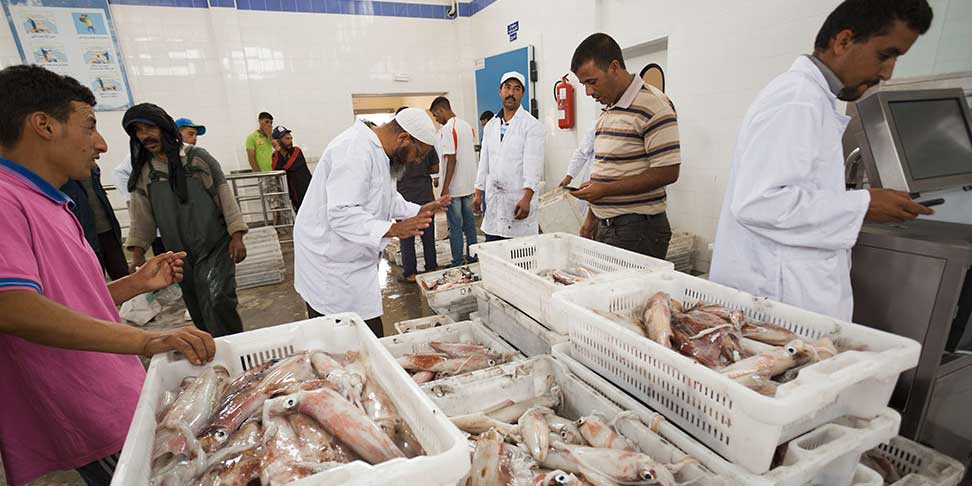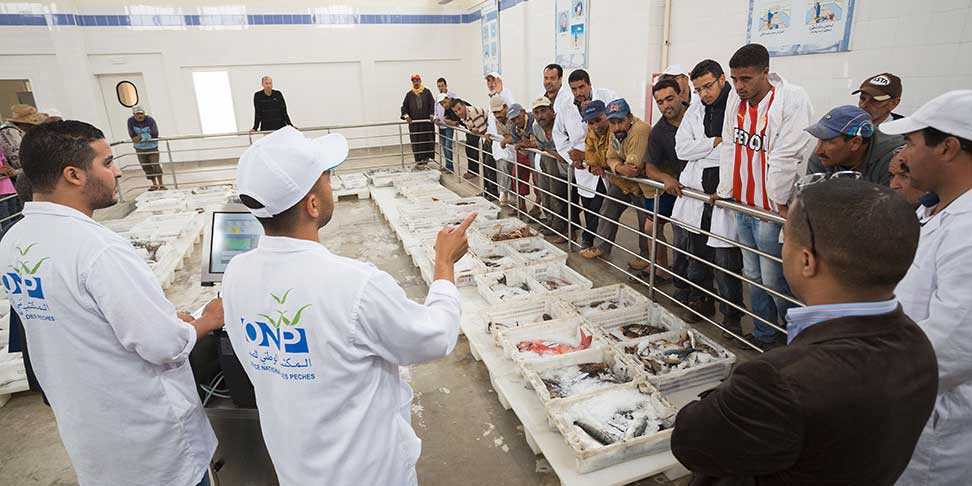Program Overview
MCC’s $650.1 million Morocco I Compact (2008-2013) funded the $111.3 million Small-Scale Fisheries Project. The project aimed to increase incomes, improving the small-scale fisheries value chain, such as using cold storage, and increasing access to markets. This was to be achieved by building landing sites and wholesale markets, upgrading port facilities, establishing three marine protected areas, subsidizing transportation upgrades for fish vendors, and providing literacy and vocational training for fishers and fish vendors. In addition, the project aimed to support women working in the sector by constructing and equipping facilities to store and prepare algae and fish for consumption.
Evaluator Description
Morocco’s Millennium Challenge Account commissioned IOS Partners, Inc. to lead an independent interim performance evaluation of the Small-Scale Fisheries Project. Interim report results and learning: https://data.mcc.gov/evaluations/index.php/catalog/161.
Key Findings
Facilities, Equipment, and Protected Areas
- By the end of the compact, 11 landing sites and 10 ports facilities were completed and operational; however five wholesale markets were constructed but not operational.
- The project subsidized 933 mobile fish vendors (72% of the adjusted target of 1300) to purchase a motorbike with an ice chest.
- Three marine protected areas were identified—Al Boran, Massa, and Mougador—each extending over a total of 40 kilometers of coastline.
Knowledge of Techniques and Environmental Management
- More than 2100 fishers and 250 mobile fish vendors participated in literacy and vocational training with reported increased understanding of hygiene and safety techniques, improved use of cold storage, and increased awareness of environmental management.
Quality of Fish, Prices, and Costs
- In Tifnit, fishers reported an increase in the average price of fish sold and a decrease in costs.
- In Tan-Tan, fishers reported an increase in the average weight of catch, a decrease in average price of fish sold, and an increase in costs.
Income and Sustainability
- Pre-post analysis suggests fishers’ self-reported annual incomes increased in both Tifnit and Tan-Tan.
- Pre-post analysis suggests mobile fish vendors’ self-reported annual incomes increased for beneficiaries compared to non-beneficiaries.
- Laws relevant to maintaining the protected areas were still not passed as of 2013, and there was no funding allocated to their management post-compact.
Evaluation Questions
The performance evaluation was designed to assess whether construction of landing sites, wholesale markets, and facilities; literacy and vocational training; and subsidized support for transportation equipment led to the desired outcomes. Did they:
- 1
Improve equipment, facilities, and protected areas? - 2
Improve fishers’ literacy and vocational knowledge? - 3
Increase price of fish sold? - 4
Reduce fishers’ costs? - 5
Increase fishers’ and mobile fish vendors’ incomes?
Although not strictly attributable to the program, the trend analysis produced by the evaluation suggests the program was among many factors that contributed to improvements in prices and costs during the evaluation period.
Detailed Findings
Facilities, Equipment, and Protected Areas

Wholesale buyers and fishermen participate in an auction of freshlycaught seafood at an MCC-funded improved fish landing site in Tifnit, on Morocco’s Atlantic Coast.
The number of landings, port facilities, and wholesale markets to be improved was reduced from 39 to 26 when assessments of proposed sites identified land ownership challenges, lack of suitability, and earlier underestimating of costs. The need for cold storage, at site of catch, landing sites, and for vendors, was targeted as a critical link in value chain. The project increased the equipment subsidy to mobile fish vendors from 30 percent to 90 percent by leveraging resources from other government programs, while reducing the number of mobile fish vendors who could be supported. As of 2013, despite the lack of formalization, fishers reported improvements in marine protected areas – such as the return of octopus in Mougador. While the two pilot projects focused on women resulted in new facilities, results were limited due to reported reluctance of husbands for the women to participate, arduous labor, dependence on middle men, and general constraints in their socioeconomic environment.
Knowledge of Techniques and Environmental Management
Fishers who participated in training reported a greater understanding of safety techniques, such as the importance of maintaining equipment to reduce failures and using life jackets and GPS on boats. Additionally, fishers reported increased use of ice to protect the quality of fish during transport, a practice that they had not considered cost-effective before they were taught about the effect of cold storage on the quality and value of their fish. Fishers also reported they became sensitive to environmental management, specifically respecting marine protected areas, fishing quotas, and returning juvenile catches.
Quality of Fish, Prices, and Costs
For these outcomes, the evaluation reviewed trends at two sites—Tifnit and Tan-Tan—which were operational for at least one year prior to the evaluation. Tifnit fishers reported a 5-14 percent increase in the average price of fish sold and a 22 percent decrease in costs. Tan-Tan fishers reported a 134 percent increase in the average weight of catch, a 35 percent decrease in average price of fish sold, and a 5 percent increase in costs. Mobile fish vendors’ also reported sales increased, with 13 percent more for beneficiaries compared to non-beneficiaries.

Income and Sustainability
In Tifnit, trend analysis on self-reported data between 2010 and 2013 suggests annual incomes increased mainly related to increases in the average price of fish sold and decreases in costs. In Tan-Tan, similar analysis suggests annual incomes increased mainly related to increases in the weight of fish caught explained by an extended reach and duration of fishing outings due to new outboard engines, GPS, and sounders. For mobile fish vendors, similar analysis suggests an increase in annual incomes for beneficiaries compared to non-beneficiaries. By project end, a sustainability plan had not been established to maintain the infrastructure and protected areas, and to continue the knowledge building that occurred during the course of the project.
MCC Learning
When constructing a new market, dedicate sufficient time to prepare, organize, and build awareness of local partners who participate in the sector prior to and during construction to facilitate timely operations.
Carefully consider the content and length of training to include practical, hands-on exercises alongside theory-based content, as suggested by program participants.
Assess participants’ willingness and ability to pay and ability to meet requirements—in this case obtaining drivers licenses—when subsidizing participant purchases.
Adapt training timeline to participant’s income-generating activities, while setting realistic targets about attendance and assessment of possible compensation to incentivize participation.
If integrating women into programs is a goal, this may require additional support to conduct communications campaigns, improve the business environment through human resources best practices, and involve women who are already engaged in similar programs to become interlocutors.
Evaluation Methods

Mobile fish vendors deliver fresh fish quickly via coolerladen motorcycles funded by the MCC project.
Small-scale fishers targeted by the project began receiving training and support in October 2011 and the Tifnit and Tan-Tan sites were completed in October 2012. However, some activities, such as the marine protected areas and fish wholesale markets, were not fully operational by compact end, resulting in an exposure period that varied across activities between 0-24 months.
This interim performance evaluation of the Small-Scale Fisheries Project used a primarily pre-post methodology relying on data from:
- Direct interviews and focus groups of functional literacy and vocational training participants at Tan-Tan, Sidi Ifni, and Tifnit;
- Quantitative data of 142 beneficiary and 161 non-beneficiary mobile fish vendors; and
- Quantitative data from National Institute of Fisheries Research quarterly surveys from 2011-2013 on activity of fishing units, including operating costs, profits, and income of fishers.
Next Steps
MCC procured Mathematica Policy Research to conduct a final evaluation of the Small-Scale Fisheries Project. This continued evaluation provides an opportunity to explore the projects’ sustainability and to measure productivity and ecosystem impacts which may have occurred after the compact’s end date in 2013. Final report expected in 2022. Supporting materials available here: https://data.mcc.gov/evaluations/index.php/catalog/264.
2020-002-2382


